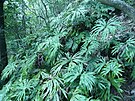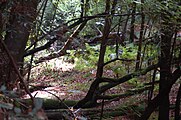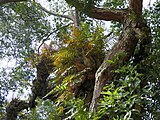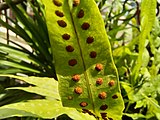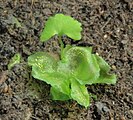Fern
This articleneeds additional citations forverification.(August 2023) |
| Ferns Temporal range:
| |
|---|---|
| Scientific classification | |
| Kingdom: | Plantae |
| Clade: | Tracheophytes |
| Division: | Polypodiophyta |
| Class: | Polypodiopsida Cronquist, Takht. & W.Zimm. |
| Subclasses[2] | |
| |
| Synonyms | |
| |
Theferns(PolypodiopsidaorPolypodiophyta) are a group ofvascular plants(plants withxylemandphloem) that reproduce viasporesand have neitherseedsnorflowers.They differ frommossesby being vascular, i.e., having specialized tissues that conduct water and nutrients, and in having life cycles in which the branchedsporophyteis the dominant phase.
Ferns have complexleavescalledmegaphyllsthat are more complex than themicrophyllsofclubmosses.Most ferns areleptosporangiate ferns.They produce coiledfiddleheadsthat uncoil and expand intofronds.The group includes about 10,560 known extant species. Ferns are defined here in the broad sense, being all of thePolypodiopsida,comprising both the leptosporangiate (Polypodiidae) andeusporangiate ferns,the latter group includinghorsetails,whisk ferns,marattioid ferns,andophioglossoid ferns.
The ferncrown group,consisting of the leptosporangiates and eusporangiates, is estimated to have originated in the lateSilurianperiod 423.2 million years ago,[3]butPolypodiales,the group that makes up 80% of living fern diversity, did not appear and diversify until theCretaceous,contemporaneous with the rise of flowering plants that came to dominate the world's flora.
Ferns are not of major economic importance, but some are used for food, medicine, asbiofertilizer,as ornamental plants, and for remediating contaminated soil. They have been the subject of research for their ability to remove some chemical pollutants from the atmosphere. Some fern species, such as bracken (Pteridium aquilinum) and water fern (Azolla filiculoides), are significant weeds worldwide. Some fern genera, such asAzolla,canfix nitrogenand make a significant input to the nitrogen nutrition ofrice paddies.They also play certain roles in folklore.
Description
[edit]Sporophyte
[edit]Extant ferns are herbaceousperennialsand most lackwoodygrowth.[4]When woody growth is present, it is found in the stem.[5]Their foliage may bedeciduousorevergreen,[6]and some are semi-evergreen depending on the climate.[7]Like the sporophytes of seed plants, those of ferns consist of stems, leaves and roots. Ferns differ fromspermatophytesin that they reproduce by spores rather than having flowers and producing seeds.[5]However, they also differ from spore-producingbryophytesin that, like seed plants, they arepolysporangiophytes,theirsporophytesbranching and producing many sporangia. Also unlike bryophytes, fern sporophytes are free-living and only briefly dependent on the maternalgametophyte.
Thegreen,photosyntheticpart of the plant is technically amegaphylland in ferns, it is often called afrond.New leaves typically expand by the unrolling of a tight spiral called a crozier orfiddleheadintofronds.[8]This uncurling of the leaf is termedcircinate vernation.Leaves are divided into two types: sporophylls and tropophylls.Sporophyllsproduce spores;tropophyllsdo not. Fern spores are borne insporangiawhich are usually clustered to formsori.The sporangia may be covered with a protective coating called anindusium.The arrangement of the sporangia is important in classification.[5]
In monomorphic ferns, the fertile and sterile leaves look morphologically the same, and both are able to photosynthesize. In hemidimorphic ferns, just a portion of the fertile leaf is different from the sterile leaves. In dimorphic (holomorphic) ferns, the two types of leaves aremorphologically distinct.[9]The fertile leaves are much narrower than the sterile leaves, and may have no green tissue at all, as in theBlechnaceaeandLomariopsidaceae.
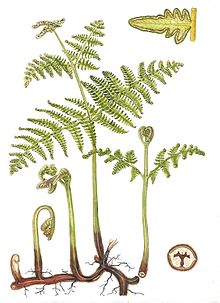
The anatomy of fern leaves can be anywhere from simple to highly divided, or evenindeterminate(e.g.Gleicheniaceae,Lygodiaceae). The divided forms arepinnate,where the leaf segments are completely separated from one other, or pinnatifid (partially pinnate), where the leaf segments are still partially connected. When the fronds are branched more than once, it can also be a combination of the pinnatifid are pinnate shapes. If the leaf blades are divided twice, the plant has bipinnate fronds, and tripinnate fronds if they branch three times, and all the way to tetra- and pentapinnate fronds.[10][11]In tree ferns, the main stalk that connects the leaf to the stem (known as the stipe), often has multiple leaflets. The leafy structures that grow from the stipe are known as pinnae and are often again divided into smaller pinnules.[12]
Fern stems are often loosely calledrhizomes,even though they grow underground only in some of the species. Epiphytic species and many of the terrestrial ones have above-ground creepingstolons(e.g.,Polypodiaceae), and many groups have above-ground erect semi-woody trunks (e.g.,Cyatheaceae,the scaly tree ferns). These can reach up to 20 meters (66 ft) tall in a few species (e.g.,Cyathea browniionNorfolk IslandandCyathea medullarisinNew Zealand).[13]
Roots are underground non-photosynthetic structures that take up water and nutrients fromsoil.They are alwaysfibrousand are structurally very similar to the roots of seed plants.
Gametophyte
[edit]As in allvascular plants,the sporophyte is the dominant phase orgeneration in the life cycle.Thegametophytesof ferns, however, are very different from those of seed plants. They are free-living and resembleliverworts,whereas those of seed plants develop within the spore wall and are dependent on the parent sporophyte for their nutrition. A fern gametophyte typically consists of:
- Prothallus:A green, photosynthetic structure that is one cell thick, usually heart or kidney shaped, 3–10 mm long and 2–8 mm broad. The prothallus produces gametes by means of:
- Antheridia:Small spherical structures that produceflagellatesperm.
- Archegonia:A flask-shaped structure that produces a single egg at the bottom, reached by the sperm by swimming down the neck.
- Rhizoids:root-like structures (not true roots) that consist of single greatly elongated cells, that absorb water and mineralsaltsover the whole structure. Rhizoids anchor the prothallus to the soil.
Taxonomy
[edit]Carl Linnaeus(1753) originally recognized 15 genera of ferns and fern allies, classifying them in classCryptogamiain two groups, Filices (e.g.Polypodium) andMusci(mosses).[14][15][16]By 1806 this had increased to 38 genera,[17]and has progressively increased since (seeSchuettpelz et al (2018)). Ferns were traditionally classified in theclassFilices, and later in aDivisionof the Plant Kingdom namedPteridophytaor Filicophyta. Pteridophyta is no longer recognised as a validtaxonbecause it isparaphyletic.The ferns are also referred to as Polypodiophyta or, when treated as a subdivision ofTracheophyta(vascular plants), Polypodiopsida, although this name sometimes only refers to leptosporangiate ferns. Traditionally, all of the spore producingvascular plantswere informally denominated thepteridophytes,rendering the term synonymous with ferns andfern allies.This can be confusing because members of the division Pteridophyta were also denominated pteridophytes (sensu stricto).
Traditionally, three discrete groups have been denominated ferns: two groups of eusporangiate ferns, the familiesOphioglossaceae(adder's tongues,moonworts,and grape ferns) andMarattiaceae;and the leptosporangiate ferns. The Marattiaceae are a primitive group of tropical ferns with large, fleshy rhizomes and are now thought to be asibling taxonto the leptosporangiate ferns. Several other groups of species were considered fern allies: theclubmosses,spikemosses,andquillwortsinLycopodiophyta;the whisk ferns ofPsilotaceae;and the horsetails ofEquisetaceae.Since this grouping ispolyphyletic,the term fern allies should be abandoned, except in a historical context.[18]More recent genetic studies demonstrated that the Lycopodiophyta are more distantly related to othervascular plants,having radiated evolutionarily at the base of the vascular plantclade,while both the whisk ferns and horsetails are as closely related to leptosporangiate ferns as theophioglossoid fernsandMarattiaceae.In fact, the whisk ferns and ophioglossoid ferns are demonstrably aclade,and thehorsetailsandMarattiaceaeare arguably another clade.
Molecular phylogenetics
[edit]Smith et al. (2006) carried out the first higher-level pteridophyte classification published in themolecular phylogeneticera, and considered the ferns as monilophytes, as follows:[19]
- DivisionTracheophyta(tracheophytes) - vascular plants
- Sub divisionEuphyllophytina(euphyllophytes)
- InfradivisionMoniliformopses(monilophytes)
- InfradivisionSpermatophyta- seed plants, ~260,000 species
- SubdivisionLycopodiophyta(lycophytes) - less than 1% of extant vascular plants
- Sub divisionEuphyllophytina(euphyllophytes)
Molecular data, which remain poorly constrained for many parts of the plants' phylogeny, have been supplemented by morphological observations supporting the inclusion of Equisetaceae in the ferns, notably relating to the construction of their sperm and peculiarities of their roots.[19]
The leptosporangiate ferns are sometimes called "true ferns".[20]This group includes most plants familiarly known as ferns. Modern research supports older ideas based on morphology that the Osmundaceae diverged early in the evolutionary history of the leptosporangiate ferns; in certain ways this family is intermediate between the eusporangiate ferns and the leptosporangiate ferns. Rai and Graham (2010) broadly supported the primary groups, but queried their relationships, concluding that "at present perhaps the best that can be said about all relationships among the major lineages of monilophytes in current studies is that we do not understand them very well".[21]Grewe et al. (2013) confirmed the inclusion of horsetails within fernssensu lato,but also suggested that uncertainties remained in their precise placement.[22]Other classifications have raised Ophioglossales to the rank of a fifth class, separating the whisk ferns and ophioglossoid ferns.[22]
Phylogeny
[edit]The ferns are related to other groups as shown in the following cladogram:[18][23][24][2]
| Tracheophyta |
| ||||||||||||
| (vascular plants) |
Nomenclature and subdivision
[edit]The classification of Smith et al. in 2006 treated ferns as four classes:[19][25]
- Equisetopsida(Sphenopsida) 1 order,Equisetales(Horsetails) ~ 15 species
- Psilotopsida2 orders (whisk fernsandophioglossoid ferns) ~92 species
- Marattiopsida1 order,Marattiales~ 150 species
- Polypodiopsida(Filicopsida) 7 orders (leptosporangiate ferns) ~ 9,000 species
In addition they defined 11 orders and 37 families.[19]That system was a consensus of a number of studies, and was further refined.[22][26]The phylogenetic relationships are shown in the followingcladogram(to the level of orders).[19][27][22]This division into four major clades was then confirmed usingmorphologyalone.[28]
|
Subsequently,ChaseandRevealconsidered both lycopods and ferns as subclasses of a class Equisetopsida (Embryophyta) encompassing all land plants. This is referred to asEquisetopsidasensu latoto distinguish it from the narrower use to refer to horsetails alone,Equisetopsidasensu stricto.They placed the lycopods into subclass Lycopodiidae and the ferns, keeping the term monilophytes, into five subclasses, Equisetidae, Ophioglossidae, Psilotidae, Marattiidae and Polypodiidae, by dividing Smith's Psilotopsida into its two orders and elevating them to subclass (Ophioglossidae and Psilotidae).[24]Christenhusz et al.[a](2011) followed this use of subclasses but recombined Smith's Psilotopsida as Ophioglossidae, giving four subclasses of ferns again.[29]
ChristenhuszandChase(2014) developed a new classification of ferns and lycopods. They used the term Polypodiophyta for the ferns, subdivided like Smith et al. into four groups (shown with equivalents in the Smith system), with 21 families, approximately 212 genera and 10,535 species;[18]
- Equisetidae(=Equisetopsida) -monotypic(Equisetales,Equisetaceae,Equisetum) horsetails ~ 20 species)
- Ophioglossidae(=Psilotopsida) - 2 monotypic orders ~ 92 species
- Marattiidae(=Marattiopsida) - 1 monotypic order (Marattiales,Marattiaceae,2 subfamilies) ~ 130 species
- Polypodiidae(=Polypodiopsida) - 7 orders
This was a considerable reduction in the number of families from the 37 in the system of Smith et al., since the approach was more that oflumpingrather than splitting. For instance a number of families were reduced to subfamilies. Subsequently, aconsensusgroup was formed, thePteridophyte Phylogeny Group(PPG), analogous to theAngiosperm Phylogeny Group,publishing their first complete classification in November 2016. They recognise ferns as a class, the Polypodiopsida, with four subclasses as described by Christenhusz and Chase, and which are phylogenetically related as in this cladogram:
| Christenhusz and Chase 2014[2] | Nitta et al. 2022[3]and Fern Tree of life[30] |
|---|---|
In the Pteridophyte Phylogeny Group classification of 2016 (PPG I), the Polypodiopsida consist of four subclasses, 11 orders, 48 families, 319 genera, and an estimated 10,578 species.[31]Thus Polypodiopsida in the broad sense (sensu lato) as used by the PPG (PolypodiopsidasensuPPG I) needs to be distinguished from the narrower usage (sensu stricto) of Smith et al. (PolypodiopsidasensuSmith et al.)[2]Classification of ferns remains unresolved and controversial with competing viewpoints (splitting vs lumping) between the systems of the PPG on the one hand and Christenhusz and Chase on the other, respectively. In 2018, Christenhusz and Chase explicitly argued against recognizing as many genera as PPG I.[16][32]
| Smith et al. (2006)[19] | Chase & Reveal (2009)[24] | Christenhusz et al. (2011)[29] | Christenhusz & Chase (2014, 2018)[18][33] | PPG I (2016)[2] |
|---|---|---|---|---|
| ferns (no rank) |
monilophytes (no rank) |
ferns (monilophytes) (no rank) |
ferns (Polypodiophyta) (no rank) |
Class Polypodiopsida |
| Class Equisetopsida | Subclass Equisetidae | Subclass Equisetidae | Subclass Equisetidae | SubclassEquisetidae |
| Class Psilotopsida | Subclass Ophioglossidae Subclass Psilotidae |
Subclass Ophioglossidae | Subclass Ophioglossidae | SubclassOphioglossidae |
| Class Marattiopsida | Subclass Marattiidae | Subclass Marattiidae | Subclass Marattiidae | SubclassMarattiidae |
| Class Polypodiopsida | Subclass Polypodiidae | Subclass Polypodiidae | Subclass Polypodiidae | SubclassPolypodiidae |
Evolution and biogeography
[edit]Fern-like taxa (Wattieza) first appear in the fossil record in the middleDevonianperiod, ca. 390Mya.By theTriassic,the first evidence of ferns related to several modern families appeared. The great fern radiation occurred in the lateCretaceous,when many modern families of ferns first appeared.[34][1][35][36]Ferns evolved to cope with low-light conditions present under the canopy of angiosperms.
Remarkably, thephotoreceptorneochrome in the two orders Cyatheales and Polypodiales, integral to their adaptation to low-light conditions, was obtained viahorizontal gene transferfromhornworts,abryophytelineage.[37]
Due to the very large genome seen in most ferns, it was suspected they might have gone throughwhole genome duplications,butDNA sequencinghas shown that their genome size is caused by the accumulation of mobile DNA liketransposonsand other genetic elements that infect genomes and get copied over and over again.[38]
Ferns appear to have evolvedextrafloral nectaries135 million years ago, nearly simultaneously with the trait's evolution in angiosperms. However, nectary-associated diversifications in ferns did not hit their stride until nearly 100 million years later, in theCenozoic.There is weak support for the rise of fern-feeding arthropods driving this diversification.[39]
Distribution and habitat
[edit]Ferns are widespread in their distribution, with the greatest richness in the tropics and least in arctic areas. The greatest diversity occurs in tropical rainforests.[40]New Zealand, for which the fern is a symbol, has about 230 species, distributed throughout the country.[41]It is a common plant inEuropeanforests.
Ecology
[edit]Fern species live in a wide variety ofhabitats,from remotemountainelevations, to drydesertrock faces, bodies of water or open fields. Ferns in general may be thought of as largely being specialists in marginal habitats, often succeeding in places where various environmental factors limit the success offlowering plants.Some ferns are among the world's most serious weed species, including thebrackenfern growing in the Scottish highlands, or the mosquito fern (Azolla) growing in tropical lakes, both species forming large aggressively spreading colonies. There are four particular types of habitats that ferns are found in: moist, shadyforests;crevices in rock faces, especially when sheltered from the full sun; acid wetlands includingbogsandswamps;and tropicaltrees,where many species areepiphytes(something like a quarter to a third of all fern species).[42]
Especially the epiphytic ferns have turned out to be hosts of a huge diversity of invertebrates. It is assumed thatbird's-nest fernsalone contain up to half the invertebrate biomass within a hectare ofrainforestcanopy.[43]
Many ferns depend on associations withmycorrhizalfungi. Many ferns grow only within specific pH ranges; for instance, the climbing fern (Lygodium palmatum) of easternNorth Americawill grow only in moist, intenselyacidsoils, while the bulblet bladder fern (Cystopteris bulbifera), with an overlapping range, is found only onlimestone.
The spores are rich inlipids,proteinandcalories,so some vertebrates eat these. TheEuropean woodmouse(Apodemus sylvaticus) has been found to eat the spores ofCulcita macrocarpa,and thebullfinch(Pyrrhula murina) and theNew Zealand lesser short-tailed bat(Mystacina tuberculata) also eat fern spores.[44]
-
In undergrowth belowcoast redwoods,California
-
Fern bed under a forest canopy, Virginia
-
On a wall
-
Epiphyticferns in India
Life cycle
[edit]Ferns arevascular plantsdiffering fromlycophytesby having trueleaves(megaphylls), which are oftenpinnate.They differ fromseed plants(gymnospermsandangiosperms) in reproducing by means of spores and lackingflowersandseeds.Like allland plants,they have alife cyclereferred to asalternation of generations,characterized by alternatingdiploidsporophyticandhaploidgametophyticphases. The diploid sporophyte has 2npairedchromosomes,wherenvaries from species to species. The haploid gametophyte hasnunpaired chromosomes, i.e. half the number of the sporophyte. The gametophyte of ferns is a free-living organism, whereas the gametophyte of the gymnosperms and angiosperms is dependent on the sporophyte.
The life cycle of a typical fern proceeds as follows:
- A diploid sporophyte phase produces haploidsporesbymeiosis(a process of cell division which reduces the number of chromosomes by a half).
- A spore grows into a free-living haploid gametophyte bymitosis(a process of cell division which maintains the number of chromosomes). The gametophyte typically consists of a photosyntheticprothallus.
- The gametophyte producesgametes(often bothspermandeggson the same prothallus) by mitosis.
- A mobile,flagellatesperm fertilizes an egg that remains attached to the prothallus.
- The fertilized egg is now a diploidzygoteand grows by mitosis into a diploid sporophyte (the typical fern plant).
Sometimes a gametophyte can give rise to sporophyte traits like roots or sporangia without the rest of the sporophyte.[45]
-
Gametophyte (thallus) and sporophyte (ascendant frond) ofOnoclea sensibilis
Uses
[edit]Ferns are not as important economically as seed plants, but have considerable importance in some societies. Some ferns are used for food, including the fiddleheads ofPteridium aquilinum(bracken),Matteuccia struthiopteris(ostrich fern), andOsmundastrum cinnamomeum(cinnamon fern).Diplazium esculentumis also used in the tropics (for example inbudu pakis,a traditional dish ofBrunei[46]) as food. Tubers from the "para",Ptisana salicina(king fern) are a traditional food inNew Zealandand theSouth Pacific.Fern tubers were used for food 30,000 years ago in Europe.[47][48]Fern tubers were used by theGuanchesto makegofioin theCanary Islands.Ferns are generally not known to be poisonous to humans.[49]Licorice fernrhizomeswere chewed by the natives of thePacific Northwestfor their flavor.[50]Some species of ferns arecarcinogenic,and the British Royal Horticultural Society has advised not to consume any species for health reasons of both humans and livestock.[51]
Ferns of the genusAzolla,commonly known as water fern or mosquito ferns are very small, floating plants that do not resemble ferns. The mosquito ferns are used as a biological fertilizer in the rice paddies of southeast Asia, taking advantage of their ability tofix nitrogenfrom the air into compounds that can then be used by other plants.
Ferns have proved resistant to phytophagous insects. The gene that express the protein Tma12 in an edible fern,Tectaria macrodonta,has been transferred to cotton plants, which became resistant towhiteflyinfestations.[52]
Many ferns are grown inhorticultureas landscape plants, forcut foliageand ashouseplants,especially the Boston fern (Nephrolepis exaltata) and other members of the genusNephrolepis.Thebird's nest fern(Asplenium nidus) is also popular, as are thestaghorn ferns(genusPlatycerium). Perennial (also known as hardy) ferns planted in gardens in the northern hemisphere also have a considerable following.[53]
Several ferns, such as bracken[54]andAzolla[55]species are noxiousweedsorinvasive species.Further examples include Japanese climbing fern (Lygodium japonicum),sensitive fern(Onoclea sensibilis) and Giant water fern (Salvinia molesta), one of the world's worst aquatic weeds.[56][57]The important fossil fuelcoalconsists of the remains of primitive plants, including ferns.[58]
Culture
[edit]
Pteridology
[edit]The study of ferns and other pteridophytes is calledpteridology.Apteridologistis a specialist in the study of pteridophytes in a broader sense that includes the more distantly relatedlycophytes.
Pteridomania
[edit]Pteridomaniawas aVictorian eracrazewhich involved ferncollectingand fern motifs indecorative artincludingpottery,glass,metals,textiles,wood,printed paper,andsculpture"appearing on everything fromchristeningpresents togravestonesand memorials. "The fashion for growing ferns indoors led to the development of theWardian case,a glazed cabinet that would exclude air pollutants and maintain the necessary humidity.[59]
Other applications
[edit]
TheBarnsley fernis afractalnamed after the BritishmathematicianMichael Barnsleywho first described it in his bookFractals Everywhere.Aself-similarstructure is described by a mathematical function, applied repeatedly at different scales to create a frond pattern.[60]
The dried form of ferns was used in other arts, such as a stencil or directly inked for use in a design. The botanical work,The Ferns of Great Britain and Ireland,is a notable example of this type ofnature printing.The process, patented by the artist and publisher Henry Bradbury, impressed a specimen on to a soft lead plate. The first publication to demonstrate this wasAlois Auer'sThe Discovery of the Nature Printing-Process.
Fern barswere popular in America in the 1970s and 80s.
Folklore
[edit]Ferns figure in folklore, for example in legends about mythical flowers or seeds.[61]InSlavic folklore,ferns are believed to bloom once a year, during theIvan Kupalanight. Although alleged to be exceedingly difficult to find, anyone who sees afern floweris thought to be guaranteed to be happy and rich for the rest of their life. Similarly,Finnishtradition holds that one who finds theseedof a fern in bloom onMidsummernight will, by possession of it, be guided and be able to travel invisibly to the locations where eternally blazingWill o' the wispscalledaarnivalkeamark the spot of hiddentreasure.These spots are protected by a spell that prevents anyone but the fern-seed holder from ever knowing their locations.[62]In Wicca, ferns are thought to have magical properties such as a dried fern can be thrown into hot coals of a fire to exorcise evil spirits, or smoke from a burning fern is thought to drive away snakes and such creatures.[63]
New Zealand
[edit]Ferns are the national emblem of New Zealand and feature on its passport and in the design of its national airline,Air New Zealand,and of its rugby team, theAll Blacks.
Organisms confused with ferns
[edit]Misnomers
[edit]Several non-fern plants (and even animals) are called ferns and are sometimes confused with ferns. These include:
- Asparagus fern—This may apply to one of several species of themonocotgenusAsparagus,which are flowering plants.
- Sweetfern—A flowering shrub of the genusComptonia.
- Air fern—A group ofanimalscalledhydrozoansthat are distantly related tojellyfishandcorals.They are harvested, dried, dyed green, and then sold as a plant that can live on air. While it may look like a fern, it is merely the skeleton of thiscolonial animal.
- Fern bush—Chamaebatiaria millefolium—a rose family shrub with fern-like leaves.
- Fern tree—Jacaranda mimosifolia—anornamental treeof the orderLamiales.
- Fern leaf tree—Filicium decipiens—anornamental treeof the orderSapindales.
Fern-like flowering plants
[edit]Someflowering plantssuch aspalmsand members of thecarrot familyhavepinnateleaves that somewhat resemble fern fronds. However, these plants have fully developed seeds contained in fruits, rather than the microscopic spores of ferns.
See also
[edit]Notes
[edit]- ^President, International Association of Pteridologists
References
[edit]- ^abStein et al 2007.
- ^abcdePteridophyte Phylogeny Group 2016.
- ^abNitta, Joel H.; Schuettpelz, Eric; Ramírez-Barahona, Santiago; Iwasaki, Wataru; et al. (2022)."An Open and Continuously Updated Fern Tree of Life".Frontiers in Plant Science.13:909768.doi:10.3389/fpls.2022.909768.PMC9449725.PMID36092417.
- ^Mauseth, James D. (September 2008).Botany: an Introduction to Plant Biology.Jones & Bartlett Publishers. p. 492.ISBN978-1-4496-4720-9.
- ^abcLevyns, M. R. (1966).A Guide to the Flora of the Cape Peninsula(2nd Revised ed.). Juta & Company.OCLC621340.
- ^Fernández, Helena; Kumar, Ashwani; Revilla, Maria Angeles (11 November 2010).Working with Ferns: Issues and Applications.Springer. p. 175.ISBN978-1-4419-7162-3.
- ^Hodgson, Larry (1 January 2005).Making the Most of Shade: How to Plan, Plant, and Grow a Fabulous Garden that Lightens Up the Shadows.Rodale. p. 329.ISBN978-1-57954-966-4.
- ^McCausland 2019.
- ^Understanding the contribution of LFY and PEBP flowering genes to fern leaf dimorphism - Botany 2019
- ^Fern Structure - Forest Service
- ^Fern Structure - Forest Service
- ^"Fern Fronds".Basic Biology. Archived fromthe originalon 19 April 2015.Retrieved6 December2014.
- ^Large, Mark F.;Braggins, John E.(2004).Tree Ferns.Timber Press.ISBN0881926302.
- ^Underwood 1903.
- ^Linnaeus 1753.
- ^abSchuettpelz et al 2018.
- ^Swartz 1806.
- ^abcdChristenhusz & Chase 2014.
- ^abcdefSmith et al.2006.
- ^Stace, Clive(2010b).New Flora of the British Isles(3rd ed.). Cambridge, UK: Cambridge University Press. p. xxviii.ISBN978-0-521-70772-5.
- ^Rai, Hardeep S. & Graham, Sean W. (2010). "Utility of a large, multigene plastid data set in inferring higher-order relationships in ferns and relatives (monilophytes)".American Journal of Botany.97(9): 1444–1456.doi:10.3732/ajb.0900305.PMID21616899.,p. 1450
- ^abcdGrewe, Felix; et al. (2013)."Complete plastid genomes from Ophioglossum californicum, Psilotum nudum, and Equisetum hyemale reveal an ancestral land plant genome structure and resolve the position of Equisetales among monilophytes".BMC Evolutionary Biology.13(1): 1–16.Bibcode:2013BMCEE..13....8G.doi:10.1186/1471-2148-13-8.ISSN1471-2148.PMC3553075.PMID23311954.
- ^Cantino et al 2007.
- ^abcChase & Reveal 2009.
- ^Schuettpelz 2007,Table I.
- ^Karol, Kenneth G.; et al. (2010)."Complete plastome sequences of Equisetum arvense and Isoetes flaccida: implications for phylogeny and plastid genome evolution of early land plant lineages".BMC Evolutionary Biology.10(1): 321–336.Bibcode:2010BMCEE..10..321K.doi:10.1186/1471-2148-10-321.ISSN1471-2148.PMC3087542.PMID20969798.
- ^Li, F-W; Kuo, L-Y; Rothfels, CJ; Ebihara, A; Chiou, W-L; et al. (2011)."rbcL and matK Earn Two Thumbs Up as the Core DNA Barcode for Ferns".PLOS ONE.6(10): e26597.Bibcode:2011PLoSO...626597L.doi:10.1371/journal.pone.0026597.PMC3197659.PMID22028918.
- ^Schneider et al 2009.
- ^abChristenhusz et al 2011.
- ^"Tree viewer: interactive visualization of FTOL".FTOL v1.3.0. 2022.Retrieved12 December2022.
- ^Christenhusz & Byng 2016.
- ^Christenhusz & Chase 2018.
- ^Christenhusz et al 2018.
- ^UCMP 2019.
- ^Berry 2009.
- ^Bomfleur et al 2014.
- ^Li, F.-W.; Villarreal, J. C.; Kelly, S.; et al. (6 May 2014)."Horizontal transfer of an adaptive chimeric photoreceptor from bryophytes to ferns".Proceedings of the National Academy of Sciences.111(18): 6672–6677.Bibcode:2014PNAS..111.6672L.doi:10.1073/pnas.1319929111.PMC4020063.PMID24733898.
- ^Genes for seeds arose early in plant evolution, ferns reveal
- ^Suissa, Jacob S.; Li, Fay-Wei; Moreau, Corrie S. (24 May 2024)."Convergent evolution of fern nectaries facilitated independent recruitment of ant-bodyguards from flowering plants".Nature Communications.15(1): 4392.Bibcode:2024NatCo..15.4392S.doi:10.1038/s41467-024-48646-x.ISSN2041-1723.PMC11126701.
- ^EB 2019.
- ^SLH 2018.
- ^Schuettpelz 2007,Part I.
- ^"Ferns Brimming With Life".Science | AAAS.2 June 2004.
- ^Walker, Matt (19 February 2010)."A mouse that eats ferns like a dinosaur".BBC Earth News.Retrieved20 February2010.
- ^The Ferns (Filicales): Volume 1, Analytical Examination of the Criteria of Comparison: Treated Comparatively with a View to their Natural Classification
- ^Indigenous Fermented Foods of Southeast Asia.2015.
- ^Van Gilder Cooke, Sonia (23 October 2010)."Stone Age humans liked their burgers in a bun".New Scientist,p. 18.
- ^Revedin, Anna et al. (18 October 2010)."Thirty thousand-year-old evidence of plant food processing".PNAS.
- ^Pelton, Robert (2011).The Official Pocket Edible Plant Survival Manual.Freedom and Liberty Foundation Press. p. 25.BNID2940013382145.
- ^Moerman, Daniel E. (27 October 2010).Native American Food Plants: An Ethnobotanical Dictionary.Timber Press. p. 190.ISBN978-1-60469-189-4.
- ^"Dol Sot Bibimbap".Archived fromthe originalon 11 November 2011.Retrieved19 December2011.
- ^Shukla, Anoop Kumar; Upadhyay, Santosh Kumar; Mishra, Manisha; et al. (26 October 2016). "Expression of an insecticidal fern protein in cotton protects against whitefly".Nature Biotechnology.34(10): 1046–1051.doi:10.1038/nbt.3665.PMID27598229.S2CID384923.
- ^"Ferns: A Classic Shade Garden Plant".extension.sdstate.edu.Retrieved30 May2023.
- ^"Datasheet:Pteridium aquilinum(bracken) ".CAB International. 2018.Retrieved11 February2019.
- ^"Datasheet:Azolla filiculoides(water fern) ".CAB International. 2018.Retrieved11 February2019.
- ^"| Center for Aquatic and Invasive Plants | University of Florida, IFAS".plants.ifas.ufl.edu.Retrieved30 May2023.
- ^Moran, Robbin (2004).A Natural History of Ferns.Timber Press.ISBN0-88192-667-1.
- ^"Fossils, Kentucky Geological Survey, University of Kentucky".www.uky.edu.Retrieved30 May2023.
- ^Boyd, Peter D. A. (2 January 2002)."Pteridomania - the Victorian passion for ferns".Antique Collecting.Revised: web version.28(6): 9–12.Retrieved2 October2007.
- ^abFractals Everywhere,Boston, MA: Academic Press, 1993,ISBN0-12-079062-9
- ^May 1978.
- ^"Traditional Finnish Midsummer celebration".Saunalahti.fi. Archived fromthe originalon 19 September 2011.Retrieved7 September2013.
- ^Cunningham, Scott(1999).Cunningham's Encyclopedia of Magical Herbs.Llewellyn. p. 102.
Bibliography
[edit]Books
[edit]- Christenhusz, Maarten M. J.;Fay, Michael;Byng, James W.(2018).The Global Flora: Special Edition: GLOVAP Nomenclature Part 1.Plant Gateway Ltd.ISBN978-0-9929993-6-0.
- Linnaeus, Carl(1753)."Cryptogamia: Filices Musci".Species Plantarum: exhibentes plantas rite cognitas, ad genera relatas, cum differentiis specificis, nominibus trivialibus, synonymis selectis, locis natalibus, secundum systema sexuale digestas.Vol. 1. Stockholm: Impensis Laurentii Salvii. pp. 1061–1100, 1100–1130.,see alsoSpecies Plantarum
- Lord, Thomas R. (2006).Ferns and Fern Allies of Pennsylvania.Indiana, PA: Pinelands Press.Ferns and Fern Allies of Pennsylvania – Thomas Reeves Lord
- Moran, Robbin C. (2004).A Natural History of Ferns.Portland, OR: Timber Press.ISBN0-88192-667-1.
- Ranker, Tom A.; Haufler, Christopher H. (2008).Biology and Evolution of Ferns and Lycophytes.Cambridge University Press.ISBN978-0-521-87411-3.
- Swartz, Olof(1806).Synopsis filicum: earum genera et species systematice complectens: adjectis lycopodineis, et descriptionibus novarum et rariorum specierum: cum tabulis aeneis quinque.Kiliae:Impensis Bibliopolii novi academici.
Journal articles
[edit]- Berry, Chris (2009)."The Middle Devonian plant collections of Francois Stockmans reconsidered".Geologica Belgica.12(1–2): 25–30.
- Bomfleur, B.; McLoughlin, S.; Vajda, V. (20 March 2014)."Fossilized Nuclei and Chromosomes Reveal 180 Million Years of Genomic Stasis in Royal Ferns".Science.343(6177): 1376–1377.Bibcode:2014Sci...343.1376B.doi:10.1126/science.1249884.PMID24653037.S2CID38248823.
- Cantino, Philip D.; Doyle, James A.; Graham, Sean W.;Judd, Walter S.;Olmstead, Richard G.;Soltis, Douglas E.;Soltis, Pamela S.;Donoghue, Michael J.(1 August 2007). "Towards a Phylogenetic Nomenclature of Tracheophyta".Taxon.56(3): 822.doi:10.2307/25065865.JSTOR25065865.
- Chase, Mark W.&Reveal, James L.(2009)."A phylogenetic classification of the land plants to accompany APG III".Botanical Journal of the Linnean Society.161(2): 122–127.doi:10.1111/j.1095-8339.2009.01002.x.
- Christenhusz, Maarten J. M.&Byng, J. W.(2016)."The number of known plants species in the world and its annual increase".Phytotaxa.261(3). Magnolia Press: 201–217.doi:10.11646/phytotaxa.261.3.1.
- Christenhusz, M. J. M.;Zhang, X. C.; Schneider, H. (18 February 2011)."A linear sequence of extant families and genera of lycophytes and ferns".Phytotaxa.19(1): 7.doi:10.11646/phytotaxa.19.1.2.
- Christenhusz, Maarten J. M.;Chase, Mark W.(2014)."Trends and concepts in fern classification".Annals of Botany.113(4): 571–594.doi:10.1093/aob/mct299.PMC3936591.PMID24532607.
- Christenhusz, Maarten J. M.;Chase, Mark W.(1 June 2018)."PPG recognises too many fern genera".Taxon.67(3): 481–487.doi:10.12705/673.2.
- May, Lenore Wile (1978). "The economic uses and associated folklore of ferns and fern allies".The Botanical Review.44(4): 491–528.Bibcode:1978BotRv..44..491M.doi:10.1007/BF02860848.S2CID42101599.
- Melan, M. A.; Whittier, D. P. (1990). "Effects of Inorganic Nitrogen Sources on Spore Germination and Gametophyte Growth in Botrychium Dissectum".Plant, Cell and Environment.13(5): 477–82.doi:10.1111/j.1365-3040.1990.tb01325.x.
- Pryer, Kathleen M.; Schneider, Harald; Smith, Alan R.; Cranfill, Raymond; Wolf, Paul G.; Hunt, Jeffrey S.; Sipes, Sedonia D. (2001). "Horsetails and ferns are a monophyletic group and the closest living relatives to seed plants".Nature.409(6820): 618–622.Bibcode:2001Natur.409..618S.doi:10.1038/35054555.PMID11214320.S2CID4367248.
- Pryer, Kathleen M.; Schuettpelz, Eric; Wolf, Paul G.; Schneider, Harald; Smith, Alan R.; Cranfill, Raymond (2004). "Phylogeny and evolution of ferns (monilophytes) with a focus on the early leptosporangiate divergences".American Journal of Botany.91(10): 1582–1598.doi:10.3732/ajb.91.10.1582.PMID21652310.
- Pteridophyte Phylogeny Group (November 2016)."A community-derived classification for extant lycophytes and ferns".Journal of Systematics and Evolution.54(6): 563–603.doi:10.1111/jse.12229.S2CID39980610.
- Schneider, Harald; Smith, Alan R.; Pryer, Kathleen M. (1 July 2009). "Is Morphology Really at Odds with Molecules in Estimating Fern Phylogeny?".Systematic Botany.34(3): 455–475.doi:10.1600/036364409789271209.S2CID85855934.
- Schuettpelz, Eric (2007). "Table 1".The evolution and diversification of epiphytic ferns(PDF)(PhD thesis).Duke University.Archived fromthe original(PDF)on 20 June 2010.Retrieved11 December2009.
- Schuettpelz, Eric; Rouhan, Germinal; Pryer, Kathleen M.; Rothfels, Carl J.; Prado, Jefferson; Sundue, Michael A.; Windham, Michael D.; Moran, Robbin C.; Smith, Alan R. (1 June 2018)."Are there too many fern genera?".Taxon.67(3): 473–480.doi:10.12705/673.1.
- Smith, Alan R.; Kathleen M. Pryer; Eric Schuettpelz; Petra Korall; Harald Schneider; Paul G. Wolf (2006)."A classification for extant ferns"(PDF).Taxon.55(3): 705–731.doi:10.2307/25065646.JSTOR25065646.
- Stein, W. E.; Mannolini, F.; Hernick, L. V.; Landling, E.; Berry, C. M. (2007). "Giant cladoxylopsid trees resolve the enigma of the Earth's earliest forest stumps at Gilboa".Nature.446(7138): 904–907.Bibcode:2007Natur.446..904S.doi:10.1038/nature05705.PMID17443185.S2CID2575688.
- Radoslaw Janusz Walkowiak (2017)."Classification of Pteridophytes - Short classification of the ferns"(PDF).IEA Paper.doi:10.13140/RG.2.2.29934.20809.
- Underwood, L. M. (1903). "The early writers on ferns and their collections.— I. Linnaeus, 1707-1778".Torreya.3(10): 145–150.ISSN0096-3844.JSTOR40594126.
Websites
[edit]- McCausland, Jim (22 February 2019)."Rediscover ferns".Garden plants.Sunset Magazine. Archived fromthe originalon 30 October 2021.Retrieved22 November2019.
- "Pteridopsida: Fossil Record".Plants: Pteridopsida.University of California Museum of Paleontology.Retrieved23 November2019.
- "Classifying and identifying ferns".Science Learning Hub.The University of Waikato.3 September 2018.Retrieved24 November2019.
- Mickel, John T.; Wagner, Warren H.; Gifford, Ernest M.; et al. (4 February 2019)."Fern".Encyclopædia Britannica.Retrieved24 November2019.
- Hassler, Michael; Schmitt, Bernd (2 November 2019)."Checklist of Ferns and Lycophytes of the World".World Ferns.Botanical Garden of the Karlsruhe Institute of Technology.Archived fromthe originalon 2 September 2017.Retrieved25 November2019.
- Pryer, Kathleen M.; Smith, Alan R.; Rothfels, Carl (2009)."Polypodiopsida".Tree of Life.
- A classification of the ferns and their allies.(Australian National Herbarium)
- A fern book bibliography.
- Register of fossil Pteridophyta
- Watson, L. and M. J. Dallwitz (2004 onwards).The Ferns (Filicopsida) of the British Isles.Archived3 March 2016 at theWayback Machine
- Ferns and Pteridomania in Victorian Scotland.
- Non-seed plant images atbioimages.vanderbilt.edu
- American Fern Society
- British Pteridological Society
- International Equisetological Association
External links
[edit] Data related toPteridophytaat Wikispecies
Data related toPteridophytaat Wikispecies Media related toPolypodiopsidaat Wikimedia Commons
Media related toPolypodiopsidaat Wikimedia Commons






